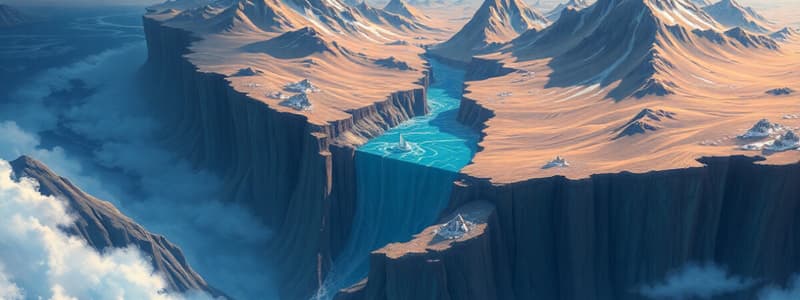Podcast
Questions and Answers
What geological feature is formed at an oceanic-oceanic convergent boundary?
What geological feature is formed at an oceanic-oceanic convergent boundary?
- Mountain range
- Fault line
- Rift valley
- Ocean trench (correct)
Which type of tectonic plate boundary is characterized by two plates moving apart?
Which type of tectonic plate boundary is characterized by two plates moving apart?
- Divergent Boundary (correct)
- Convergent Boundary
- Continental-continental Boundary
- Transform Boundary
What process occurs when an oceanic plate converges with a continental plate?
What process occurs when an oceanic plate converges with a continental plate?
- Rifting
- Subduction (correct)
- Transform faulting
- Plate sliding
What type of geological structure is typically created by continental-continental convergence?
What type of geological structure is typically created by continental-continental convergence?
What is the primary cause of plate movement in tectonic plates?
What is the primary cause of plate movement in tectonic plates?
Which of the following best describes a transform boundary?
Which of the following best describes a transform boundary?
What occurs during the process of subduction?
What occurs during the process of subduction?
What is created when continental crust stretches and separates?
What is created when continental crust stretches and separates?
Flashcards
Tectonic plates
Tectonic plates
Huge pieces of Earth's crust and upper mantle that fit together and move relative to each other.
Convergent boundaries
Convergent boundaries
Where two tectonic plates collide, the denser plate sinks below the less-dense plate.
Oceanic-oceanic convergent boundary
Oceanic-oceanic convergent boundary
A convergent boundary where one oceanic plate subducts beneath another.
Oceanic-continental convergent boundary
Oceanic-continental convergent boundary
Signup and view all the flashcards
Continental-continental boundaries
Continental-continental boundaries
Signup and view all the flashcards
Divergent boundaries
Divergent boundaries
Signup and view all the flashcards
Transform boundaries
Transform boundaries
Signup and view all the flashcards
Convection currents
Convection currents
Signup and view all the flashcards
Study Notes
Plate Boundaries
- Tectonic plates are large pieces of crust and rigid upper mantle, fitting together to cover Earth's surface.
- Plates move in different directions and at varying speeds relative to each other.
- Interactions at plate boundaries generate geological features and processes.
Convergent Boundaries
- Convergent boundaries involve two plates moving towards each other.
- When two plates collide, the denser plate subducts (dives beneath) the less dense plate.
- Subduction zones lead to the formation of trenches and volcanic arcs.
Types of Convergent Boundaries
Oceanic-Oceanic
- A subduction zone forms when one oceanic plate, denser due to cooling, descends below another.
- This process creates an ocean trench and a volcanic island arc parallel to the trench.
Oceanic-Continental
- When a denser oceanic plate converges with a continental plate, the oceanic plate subducts.
- This interaction results in a trench and a volcanic mountain range.
Continental-Continental
- Collisions between continental plates occur after an oceanic plate has converged with a continental plate.
- This results in a vast mountain range like the Himalayas.
Divergent Boundaries
- Divergent boundaries are where plates move apart.
- On continents, the separation of continental crust forms a rift valley.
- New crust is created by magma rising at these boundaries.
Transform Boundaries
- Transform boundaries involve plates sliding horizontally past each other.
- These boundaries are often marked by long faults and shallow earthquakes.
Causes of Plate Movement
- Convection currents in the mantle are a primary driver for plate movement.
- Heated material rises, cools, and sinks, creating circular motion.
- This movement transfers heat energy from Earth's interior to the exterior and moves the crust.
Ridge Push and Slab Pull
- Ridge push is the force generated by the elevated ridge pushing oceanic plate towards subduction zones.
- Slab pull happens when the weight of dense subducting plate pulls the trailing slab.
Studying That Suits You
Use AI to generate personalized quizzes and flashcards to suit your learning preferences.




